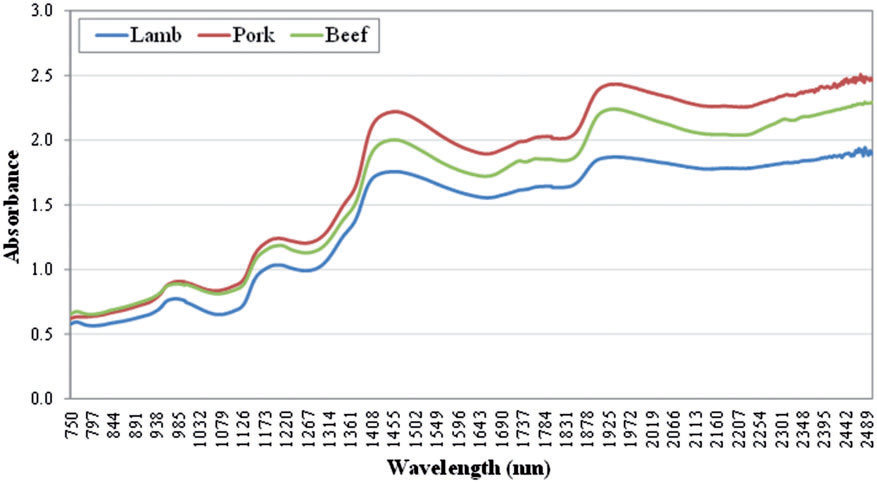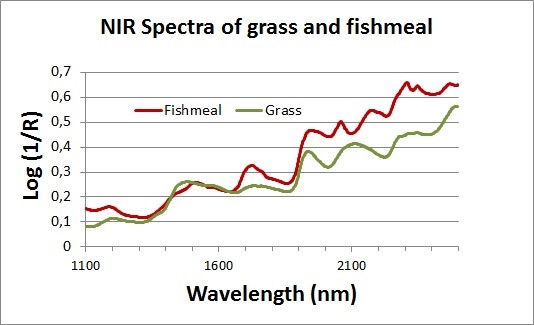September 10, 2020 at 2:33 am | Updated September 10, 2020 at 2:33 am | 7 min read
Establishing the authenticity of fresh and processed products is a vital segment of the food sector. Most food is transported long distances and consumers have become more conscious of the quality and health implications of the food they eat. As such, trust in suppliers and personal knowledge of products is being replaced by a growing number of rules and regulations that are only getting stricter. Objective and precise analysis of internal parameters by small portable NIR tools is making authentication more simple and rapid.
Prior Applications of NIR Spectroscopy
Near-infrared (NIR) spectroscopy is a complex technique that was earlier restricted to laboratories and large organizations.
NIR is a part of the light spectrum that is ideal for identifying and quantifying biological compounds, as it reacts with the bonds that hydrogen forms with oxygen, carbon, and nitrogen (H-0, H-C, and H-N). Based on their chemical composition, compounds will absorb, reflect, and transmit varying amounts of NIR. This property has been widely used in the food industry.
Subscribe to the Felix instruments Weekly article series.
By submitting this form, you are consenting to receive marketing emails from: . You can revoke your consent to receive emails at any time by using the SafeUnsubscribe® link, found at the bottom of every email. Emails are serviced by Constant Contact
The development of small portable instruments, improvement in software, and electronics has further widened the applications of NIR spectroscopy.
This new wave of portable devices was first used for measuring the internal quality parameters of horticultural crops in the field as well as during storage, transport, and retailing.
Portable and online NIR tools are now also being used for process control, authenticity, and classification.
Authenticity is needed not only for fruits and vegetables, but also for animal and processed food, like wine, cheese, oils, etc.
Food products need to be authenticated for several reasons, and we will discuss some of the common applications of NIR spectroscopy below.
Ensure and Enforce Regulations
Increasing volumes of food are being exported around the world, to places where people are traditionally unfamiliar with the products. Hence, there are international standards defined by internal chemical composition to help producers, suppliers, and retailers prevent fraud and mix-ups. This way, a consumer can be sure of the quality and authenticity of the products they buy.
These standards can be controlled by various internal quality parameters. In the case of processed fruit products, it can be sugar content measured by BRIX, titratable acidity, color, dry matter content, or presence of characteristic bio-chemicals.
Cheese types are defined by standards of a fixed percentage of fat, protein, and water content that can differ by country. For example, in Canada, cheddar is characterized by 31% fat and 39% water, and mozzarella is categorized by 20% fat and 52% moisture. Mozzarella from Italy, however, can have up to 45% fat. So, NIR can also identify the country of origin of cheese.
The Alcohol and Tobacco Tax and Trade Bureau of the US Treasury Department (TTB) has set rules to define various categories of distilled spirits, wines, and beers in terms of appearance, taste, and aroma.
Another area where NIR tools are used is in organic product certification. Here, it is necessary to detect the presence of undesirable chemical fertilizers, pesticides, and weedicides on food or in oil or wine.
Simple, user-friendly NIR tools can confirm and enforce these standards throughout the supply chain, as their measurements are both objective and precise.
Quality standards
Fresh and processed foods are graded based on their quality, which is used to determine their value. Therefore, it is important for producers to safeguard and also prove the high quality of their products, which can be done best by objective analysis of internal parameters. Most of the parameters can be easily and accurately measured by small, portable tools allowing products to be monitored throughout the supply chain to confirm their grade and value.
Some of the main areas where NIR tools are being used for this purpose are in the production of wine, olive oil, and meat products, which is not possible on site with conventional methods.
- Wine Grading: The effect of grading is best seen in wines. They are classified based on color, sugar and alcohol content, pH, acidity, and minute amounts of compounds, such as phenols, anthocyanins, etc. Also, some aspects of taste and flavor detected by NIR tools—manually, online, or inline—can judge wine style.
- Olive Oil: The percentage of the hydrophilic phenols (found only in olives), free fatty acids, aliphatic alcohols, chlorophylls, carotenoids, hydrocarbons, acidity, and oil content are used to grade olive oils and establish its authenticity. For example, acidity in extra virgin olive oil should be less than 0.8%, while ordinary oil can have up to 2% acidity.
- Meat products: NIR spectroscopy tools can precisely identify and quantify the percentage of fat, protein, and moisture but not carbohydrates. Since the distribution of fat, protein, and moisture will differ in an animal, each cut of meat can be identified and graded accurately. In pork, the maximum levels of soft fat permissible in fresh, processed, and dried products, as specified by countries, can also be identified by NIR tool use.
Confirming Origin

Figure 1. Near-infrared spectra of meat from different animals are unique. (Image credits:DOI: 10.1177/0003702817709299)
Another important area of food authentication is the origin of the products. This could be an issue of geography, species, or variety.
- Geographical origin: It is possible to confirm the geographical origin and even the method of cultivation and processing with NIR tools. Consider, for example, the famous Alphonso mangoes. The taste and flavor of the ecotype growing in Maharashtra are different from the same variety grown elsewhere in India or the tropics due to a unique combination of soil and weather conditions. Hence, the original Alphonso is worth more than the same variety grown elsewhere, and its place of origin can be determined only by precise chemical analysis.
- Species and variety: Similarly, to prevent fraud, NIR tools easily identify the spectral signature in animal products unique to each species. This is possible in cuts, frozen, and processed products, using proportions of fat, protein, and moisture; see Figure 1. For example, it is possible to differentiate between horse, llama, and cattle meat.
Detecting Contamination and Adulteration
To keep a product authentic, it is necessary to ensure that there is no adulteration. Sadly, substituting expensive, good quality ingredients for cheap, and sometimes unhealthy, substitutes is not rare in the food industry.
This issue not only occurs when conventional products are passed off as organic produce, but also in the use of ingredients in processed products. In either case, physical appearance and taste does not help in determining authenticity. Therefore, NIR tools can help by analyzing internal composition.
The percentage of hydrophilic phenols unique to olive oils is used to detect adulteration of premium oils with cheaper varieties or an entirely different plant oil.
Soya’s unique NIR spectral data is often used to detect its quantities in beef sausages, as it is an allergen. Or cheaper horse meat and pork used in food labeled as beef burgers and lasagnas can be spotted by the different spectra of the animal meats.

Figure 2: “Figure 1: + spectra of vegetal and animal feed particles in the 1100-2500 nm range.” (Image credits: https://www.feedipedia.org/content/nir-based-detection-contaminants-food-and-feed)
NIR tools can test fodder for animals to confirm that they do not contain forbidden ingredients to prevent problems like mad cow disease. NIR tools can quickly show if any harmful material of animal origin is present in compound and prepared feed. This can ensure not only food quality, but prevent undue losses for producers.
NIR Tools for Authentication
Several tools can be used manually, inline, or online. Felix Instruments Applied Food Science manufactures portable NIR tools that are small, hand-held devices, which can analyze the dry matter, titratable acidity, total soluble solids (TSS or Brix), and color.
The tools give individual readings within a few seconds that are easy to understand. These NIR tools can be used anywhere in the supply chain from producers on the farm to retailers.
F-750 Produce Quality Meter is a general tool that can be used for any fresh fruit, vegetable, fish, or meat product. There are starter models for several items, and for others, models can be easily created by following simple instructions.
There are a few devices derived from the F-750 that have been customized for specific fruits, such as avocados, mangoes, and kiwis:
Focus of Research
Half of the studies on NIR use in the food industry deal with authentication and classification studies (besides process monitoring), which shows the important emphasis placed on ensuring food authenticity. As the food economy becomes increasingly globalized, the importance of this step and these NIR tools will only increase.
—
Vijayalaxmi Kinhal
Science Writer, CID Bio-Science
Ph.D. Ecology and Environmental Science, B.Sc Agriculture
Feature image courtesy of Motion Array
Sources
Buccheri, M., Grassi, M., Lovati, F., Petriccione, M., Rega, P., Scalzo, R. L., & Cattaneo, T. M. (2019). Near infrared spectroscopy in the supply chain monitoring of Annurca apple. Journal of Near Infrared Spectroscopy, 27(1), 86–92. doi: 10.1177/0967033518821829
Cattaneo, & Stellari. (2019). Review: NIR Spectroscopy as a Suitable Tool for the Investigation of the Horticultural Field. Agronomy, 9(9), 503. doi:10.3390/agronomy9090503
Cozzolino, D., Dambergs, R.G., Janik, L., Cynkar, W.U., & Gishen, M. (2006) “Analysis of Grapes and Wine by near Infrared Spectroscopy,” J. Near Infrared Spectrosc. 14, 279-289. Retrieved from https://www.researchgate.net/publication/244738494_Analysis_of_grapes_and_wine_by_near_infrared_spectroscopy/link/00b7d52f7fcf4d41a3000000/download
Jiang, H., Zhuang, H., Sohn, M., & Wang, W. (2017). Measurement of Soy Contents in Ground Beef Using Near-Infrared Spectroscopy. Applied Sciences, 7(1), 97. doi: 10.3390/app7010097
Gardner, D.M. (2016, May, 25). Wine Analytical Labs: How Your Winery Can Use Them. Retrieved from https://extension.psu.edu/wine-analytical-labs-how-your-winery-can-use-them
Holroyd, S. (2011). NIR Analysis of Cheese—A Fonterra Perspective. NIR News, 22(6), 9–11. doi: 10.1255/nirn.1264
Lawrence, F. (2013, February 15). Horsemeat scandal: the essential guide. Retrieved from https://www.theguardian.com/uk/2013/feb/15/horsemeat-scandal-the-essential-guideMahesar, S.S., Lucarini, M., Durazzo, A., Santini, A., Lampe, A.I., & Kiefer, J. (2019). Application of Infrared Spectroscopy for Functional Compounds Evaluation in Olive Oil: A Current Snapshot. Journal of Spectroscopy, 2019, 11 pages. DOI: https://doi.org/10.1155/2019/5319024
NIR-based detection of contaminants in food and feed. (n.d.). Retrieved August 08, 2020, from https://www.feedipedia.org/content/nir-based-detection-contaminants-food-and-feed
Pillonel, L., Luginbühl, W., Picque, D. et al. Analytical methods for the determination of the geographic origin of Emmental cheese: mid- and near-infrared spectroscopy. Eur Food Res Technol 216, 174–178 (2003). https://doi.org/10.1007/s00217-002-0628-5
TTB Issues Final Rule Modernizing Labeling and Advertising Regulations for Alcoholic Beverages. (n.d.). Retrieved August 08, 2020, from https://www.jdsupra.com/legalnews/ttb-issues-final-rule-modernizing-73937/
Related Products
- F-751 Grape Quality Meter
- Custom Model Building
- F-901 AccuStore
- F-751 Melon Quality Meter
- F-751 Kiwifruit Quality Meter
- F-750 Produce Quality Meter
- F-751 Avocado Quality Meter
- F-751 Mango Quality Meter
- F-900 Portable Ethylene Analyzer
- F-950 Three Gas Analyzer
- F-920 Check It! Gas Analyzer
- F-960 Ripen It! Gas Analyzer
- F-940 Store It! Gas Analyzer
Most Popular Articles
- Spectrophotometry in 2023
- The Importance of Food Quality Testing
- NIR Applications in Agriculture – Everything…
- The 5 Most Important Parameters in Produce Quality Control
- Melon Fruit: Quality, Production & Physiology
- Fruit Respiration Impact on Fruit Quality
- Guide to Fresh Fruit Quality Control
- Liquid Spectrophotometry & Food Industry Applications
- Ethylene (C2H4) – Ripening, Crops & Agriculture
- Active Packaging: What it is and why it’s important






